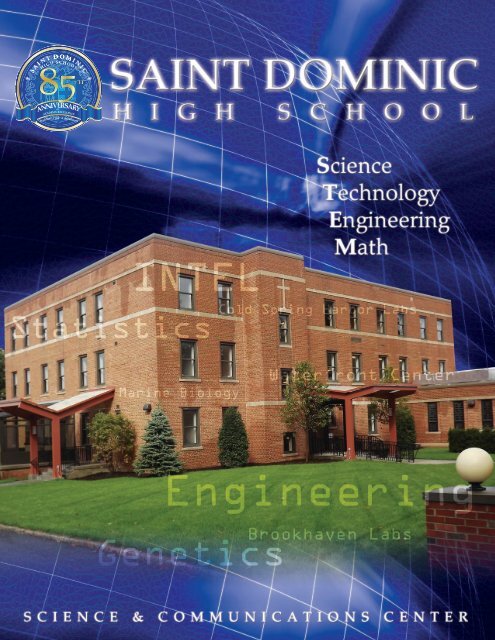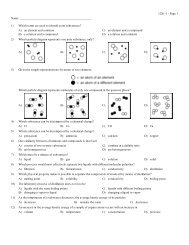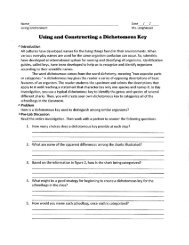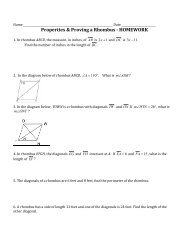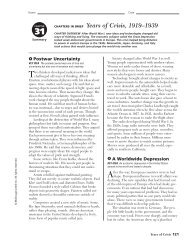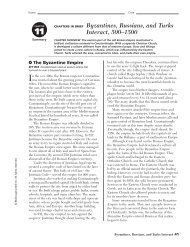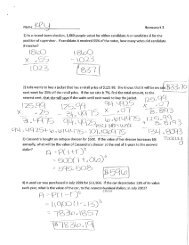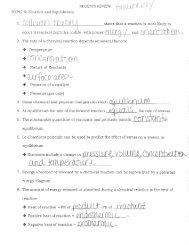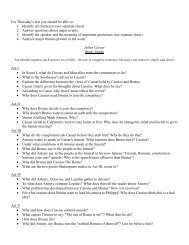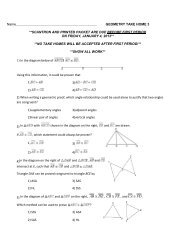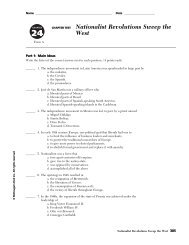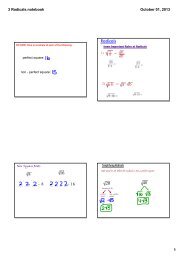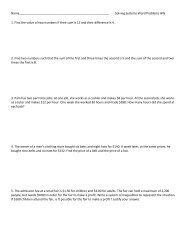St Dominic STEM.indd - St. Dominic High School
St Dominic STEM.indd - St. Dominic High School
St Dominic STEM.indd - St. Dominic High School
You also want an ePaper? Increase the reach of your titles
YUMPU automatically turns print PDFs into web optimized ePapers that Google loves.
Teresa Kuehhas M.A.<br />
Saint <strong>Dominic</strong> H.S.: Research Specialist/Mentor<br />
Dr. Bruce Nash Ph.D<br />
Cold Spring Harbor DNA Learning Center<br />
Here at Saint <strong>Dominic</strong> we are offering a way to give our students<br />
hands on science experiences; The <strong>STEM</strong> Scholar Program<br />
supports the development of independent student research.<br />
The <strong>STEM</strong> Scholar Program will begin an innovative mentoring<br />
system for student projects in science, technology, engineering and<br />
mathematics (<strong>STEM</strong>).<br />
Saint <strong>Dominic</strong> <strong>High</strong> <strong>School</strong> eagerly welcomes students to apply<br />
for this innovative program beginning in the fall of 2014. After<br />
students enroll they will then have the opportunity to apply to<br />
The <strong>STEM</strong> Scholar Program. They will have the opportunity to<br />
complete all the traditional <strong>High</strong> <strong>School</strong> graduation requirements<br />
while simultaneously completing a challenging and enriching<br />
research-based sequence of <strong>STEM</strong> courses and experiences. Under<br />
our program, the experience of enhancing students’ long-term<br />
research is captured.<br />
A 21st Century Education<br />
The <strong>STEM</strong> Scholar Program is a rigorous academic program with<br />
a focus on research at Cold Spring Harbor, Brookhaven labs and<br />
the Waterfront Center during the freshman, sophomore, junior<br />
and senior years. This program seeks to prepare students to<br />
produce publishable research, succeed in the prestigious Intel<br />
and Siemens science and math competitions, and pursue college<br />
degrees in <strong>STEM</strong> fields.<br />
<strong>STEM</strong> education has become such a vital part of secondary<br />
education. <strong>STEM</strong> education is a critical component to prepare<br />
students for today’s most in-demand jobs. Saint <strong>Dominic</strong> is<br />
committed to providing a 21st Century education to our students<br />
and offering <strong>STEM</strong> to all of our students.<br />
<strong>St</strong>. <strong>Dominic</strong> <strong>High</strong> <strong>School</strong> 3D Science<br />
As part of its continuing efforts to improve science education and<br />
maximize the resources of its new Science and Communications<br />
Center, <strong>St</strong>. <strong>Dominic</strong> <strong>High</strong> <strong>School</strong> will begin to utilize 3D content in<br />
each of its science labs to enhance instruction by November 2013.<br />
3D content offers students the opportunity to visualize and interact<br />
with scientific concepts in a more comprehensive and concrete<br />
way by providing enhanced depth and scale, making it easier<br />
to understand complicated structures and processes. 3D videos,<br />
simulations and interactive diagrams bring lessons to life in a way<br />
that 2D content cannot. The increased use of media in the classroom<br />
also furthers the school’s goal of differentiating instruction<br />
to address a variety of learning styles. In addition, research from<br />
the International Research Agency shows a 46% increase in student<br />
engagement and a 34% increase in test scores with the use of<br />
3D media which clearly demonstrates the value of implementing<br />
this new type of instructional material.<br />
In order to provide a wide variety of content across the sciences,<br />
we utilize the Design mate content library which offers<br />
350 videos and over 200 simulations. The unique combination of<br />
3D videos, simulations, experiments, learning activities, quizzes,<br />
texts, images and learning objects provides teachers with an<br />
additional tool to enhance classroom instruction. Each science lab<br />
is equipped with a 3D ready interactive projector and computer<br />
with upgraded video card. A class set of 3D glasses is available so<br />
that all science teachers and students can take advantage of this<br />
valuable new teaching tool.
OUR FUTURE LEADERS<br />
Kevin Podell ’13 NJIT Brian Slivonik ’13 Florida Southern Giovanni McCreath ‘14<br />
RNAi: Cancer in C. elegans<br />
Our project was focused around the process of RNAi which<br />
scientists believe may one day help them find cures to some<br />
of the world’s deadliest genetic disorders including cancer,<br />
Parkinson’s disease and Alzheimer’s disease. In our project we<br />
found genes associated with cell division and tumor development<br />
in humans (processes that when done improperly can lead to<br />
cancer development). We tested the effects of running RNAi on<br />
C. elegans using four genes (TERT-1, ATG-1, AGE-1 and RAD-<br />
51) both individually and in combinations and then observed<br />
the resulting phenotypes. We wanted to see whether silencing<br />
multiple genes had any amplified or new phenotypes. We learned<br />
through our observations that silencing multiple genes has major,<br />
mostly lethal results on the C. elegans.<br />
Zachary Cangemi ‘13 Colby Mark Flynn ‘14 Columbia Phillip Catapano ’13 Villanova<br />
Testing the Effects of a Medium on Plant Growth<br />
Our project demonstrated the differences in plant growth between<br />
those grown in a hydroponic setup and those grown in soil. We<br />
used jalapeno peppers and basil and placed half of each in soil<br />
and half in a hydroponic setup. We used a tank filled with nine<br />
gallons of water and a piece of <strong>St</strong>yrofoam to hold the plants in<br />
place. Nutrient solution was then added to the tank on a weekly<br />
basis to make up for the loss of resources in the new medium. In a<br />
period of three weeks, we noticed significant differences between<br />
the plants. Those grown in soil had much shorter stems, smaller<br />
leaf size, and less root growth compared to the hydroponic plants.<br />
The Effect of Electromagnetic Radiation on Plant Growth<br />
We conducted an experiment in which the growth of green lentil<br />
seeds was subjected to electromagnetic radiation sources nearby.<br />
The control group not placed near the radiation had the tallest and<br />
healthiest looking stems. The group exposed to radiation waves<br />
at strength of 11 from a wireless router had shorter stems than the<br />
Mackenzie Walsh ’14 Caitlyn Sullivan ’14<br />
control and took longer to grow to maximum height. The group<br />
exposed to the strongest electromagnetic wavelength of 30 radio<br />
waves, had the shortest stem height. This research shows that<br />
radiation given off by today’s technology has a negative effect on<br />
plants nearby.<br />
Toniann Pasqueralle ’13 Fordham<br />
Milgram’s Experiment Reinvented<br />
<strong>St</strong>anley Milgram, an American Psychologist, conducted various<br />
studies and published articles on obedience to authority. Milgram<br />
was influenced by the events of the Holocaust, and wondered<br />
why the Nazis had killed so many people, even if they knew<br />
that killing was wrong. Milgram proposed an experiment to test<br />
whether or not a person’s morality affected their obedience.<br />
Out experiment tested students’ decisions to administer “high<br />
voltage shocks” to classmates who answered a set of questions<br />
wrong. The students did not know that these shocks were<br />
Kellie Higgins ’13 Hofstra<br />
simulated. We found mixed reactions to the experiment. Six<br />
out of seven girls tested carried out the entire experiment. The<br />
7th girl dropped out halfway through. All seven boys carried<br />
out the entire experiment. Three students didn’t hesitate to flip<br />
the next switch because they wanted the person to feel the pain<br />
quickly and get it with. We concluded that gender did not affect<br />
the results in the slightest, but some of the subjects said that the<br />
physical appearance of the subject might have influences their<br />
decision to continue with the experiment.
OUR FUTURE LEADERS<br />
Jordyn Coyne ’13 Notre Dame Marissa Licata ’13 <strong>St</strong>onehill Amanda DeFeo ’13 NYU<br />
The Effects of OR2J3 on One’s Senses, Ability to Smell<br />
cis-3-hexan-1-ol, and Preference of Tomatoes<br />
Our research determines how genetics may be involved in a person’s preference towards food. We believe that a certain odor receptor,<br />
OR2J3, influences a person’s preference towards tomatoes. To test our theory we conducted different “smell trials” with our subjects<br />
using the chemical cis-3-hexen-1-ol. The odor receptor OR2J3 is vital to smell the grassy, green aroma of cis-3-hexen-1-ol. Cis-3-<br />
henxen-1-ol is naturally found in tomatoes, leading us to theory that individuals that contain the odor receptor, OR2J3, would have a<br />
preference towards tomatoes. Extracting and sequencing DNA was done to analyze individual’s genes and search for polymorphisms<br />
that potentially could restrict one’s ability to smell the aroma. Those that had difficulty in smelling cis-3-hexen-1-ol in different<br />
concentrations would most likely not contain the odor receptor, OR2J3. Our results had shown the majority of our test group did<br />
contain OR2J3, while the others had a polymorphism that obstructed their ability to smell. There was a small correlation between the<br />
odor receptor and preference towards tomatoes. However, results may have been varied due to personal choice.


